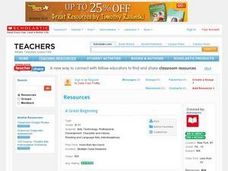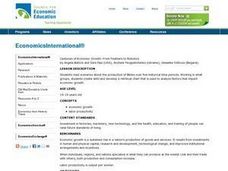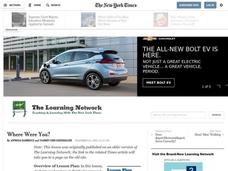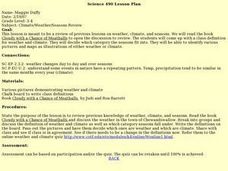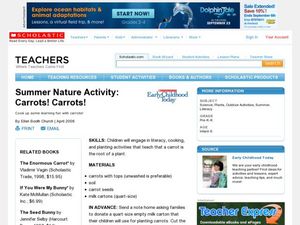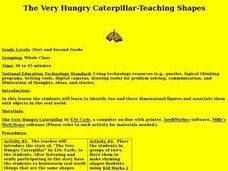Curated OER
Humans and the Natural World Poetically
Students read poetry for gist and find images to create a visual narrative. In this poetry lesson, students read Green Lane and Flies and Nettles to examine the relationship between humanity and the nature. Students reflect...
Curated OER
Treaties- Grade 9
Students discover historical and current issues regarding First Nations Treaties. In this Canadian history lesson, students read and analyze treaties made between the Canadian government and the native people of the land. Students...
Curated OER
What Are Our Common Values?
Students make a poster. In this values instructional activity, students read the Preamble to the Constitution and discuss the core democratic values that are found there and in the Declaration of Independence. Students are each...
Curated OER
A Great Beginning
Learners create tri-fold biographical brochures. Each of the sections of the brochure refers to either the past, present or future of the student. They use the back of the brochure to list ways to be successful in high school and reach...
Curated OER
Outside interview
Students refine their fieldwork skill by conducting interviews. From the position of an outsider, they conduct research and interviews. Student interviews are maintained as a part of a portfolio. Interview kits and assessment...
Curated OER
Arthropods at Home- Spider, Isopod, or Any Arthropod
Students design a habitat for an arthropod. In this organisms lesson, students read the book, A House is a House For Me. Students find an arthropod and create a terrarium.
Curated OER
Teaching Kindness across the Curriculum: Kindness for a Day, a Week, a Month, a Year
Learners investigate the concept of character kindness in literature. In this human character lesson plan, students read about kindness and write about their understanding of it.
Curated OER
Tristram Shandy by Laurence Sterne
In this online interactive reading comprehension worksheet, students respond to 25 short answer and essay questions based on Sterne's Tristam Shandy. Students may also access an online quiz on the selection using the link at...
Curated OER
What Have We Done?
Young scholars investigate the effect of dams on the ecosystem. In this environmental lesson, students read case studies on the Aswan Dam and the Colorado River Basin and construct a T-chart to compare the effects on the region.
Curated OER
Marine Archaeology
Students examine marine archaeology. In this archaeological data lesson, students see how archaeologists use data to make inferences about shipwrecks. Students read data and make their own inferences, write about marine life and...
Curated OER
Climate Change
Students read about climate change and pair share. In this climate change instructional activity, students take notes on a worksheet from the readings. Students each read a part of an article and share what they have learned.
Curated OER
Centuries of Economic Growth: From Feathers to Robotics
Students read scenarios about the production of Bibles over five historical time periods. Working in small groups, students create skits and develop a retrieval chart that is used to analyze factors that impact economic growth.
Curated OER
Where Were You?
Students examine various New York Times readers' reflections on the life and death of President John F. Kennedy, by reading and discussing "Readers Reflect on President John F. Kennedy." Students then write their own personal...
Curated OER
A History of Journal Writing
Students articulate their prior knowledge concerning the purposes of journal writing. They explore what function journal writing has fulfilled for various cultures and peoples. Students read and analyze various journal entries by famous...
Curated OER
Climate Weather Seasons Review
Students review the concepts of weather, climate, and seasons. They read and discuss a book about weather. Students collaborate on a class definition for climate and weather. They match weather to the specific season. Students...
Curated OER
How I Became Me
Students examine their own identities and read about the experiences of adopted Chinese daughters celebrating the Jewish rite of passage, the bat mitzvah. They write personal poems or speeches illustrating how their identities evolved.
Curated OER
Summer Nature Activity: Carrots! Carrots!
Young scholars investigate reading, cooking, and planting activities that teach that a carrot is the root of a plant. In this early childhood science lesson, students explore the world around them as they read The Carrot Seed and...
Curated OER
Introduction to Spiders
Students discover various facts about spiders including different species, body parts, and types of webs. In this insect biology activity, students begin a K-W-L chart about spiders, are read I Love Spiders by John Parker and...
Curated OER
Contraception, Day 3: What's the Best Method
Students describe emotional and ethical factors that influence decisions regarding contraception. They read and discuss case studies, and complete a worksheet.
Curated OER
The Very Hungry Caterpillar - Teaching Shapes
Students identify two- and three-dimensional figures and associate them with real-world objects. In this geometry lesson, students are read The Very Hungry Caterpillar by Eric Carle and complete several activities including a chart...
Curated OER
Montana Animal stacks
Students view Ode to Chief Seattle and create an animal sculpture. In this art instructional activity, students choose a variety of materials for creating an animal sculpture using flora and fauna and other environmental...
Facing History and Ourselves
What is Community?
Sixth graders contrast communities with groups. In this community lesson, 6th graders read "What is Community?" and discuss attributes of communities that distinguish them from groups.
Curated OER
Historical Markers
Learners read the "Chicago Tribute Markers of Distinction," and pick one famous person to write about. In this creative writing worksheet, students write about this person's home. Additionally, learners pretend that 100 years from now, a...
Curated OER
Nutrients by the Numbers
Students read and discuss an article on the amount of sugar in various food products. They compare the nutritional values of food products, calculate their daily intake of nutrients, analyze serving sizes, and compare/contrast their own...



